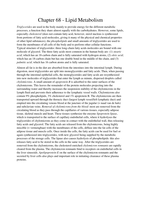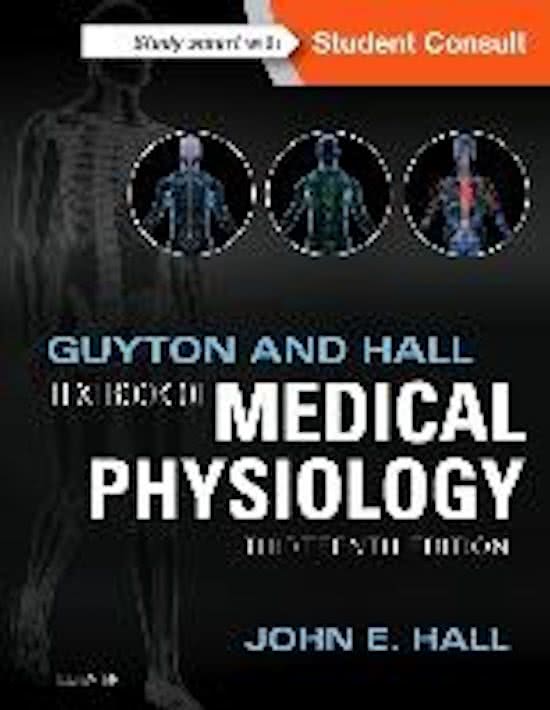Chapter 68 - Lipid Metabolism
Triglycerides are used in the body mainly to provide energy for the different metabolic
processes, a function they share almost equally with the carbohydrates. However, some lipids,
especially cholesterol (does not contain fatty acid, however, sterol nucleus is synthesized
from portions of fatty acid molecules, giving it many of the physical and chemical properties
of other lipid substances), the phospholipids and small amounts of triglycerides are used to
form the membranes of all cells of the body and to perform other cellular functions.
Typical structure of triglycerides: three long-chain fatty acids molecules are bound with one
molecule of glycerol. The three fatty acids most common in the human body are: (1) stearic
acid; which has an 18-carbon chain and is fully saturated with hydrogen atoms, (2) oleic acid;
which has an 18-carbon chain but has one double bond in the middle of the chain, and (3)
palmitic acid; which has 16 carbon atoms and is fully saturated.
Almost all fat is in the diet are absorbed from the intestines into the intestinal lymph. During
digestion, most triglycerides are split into monoglycerides and fatty acids. Then, when passing
through the intestinal epithelial cells, the monoglycerides and fatty acids are resynthesized
into new molecules of triglycerides that enter the lymph as minute, dispersed droplets called
chylomicrons. A small amount of apoprotein B is adsorbed to the outer surfaces of the
chylomicrons. This leaves the remainder of the protein molecules projecting into the
surrounding water and thereby increases the suspension stability of the chylomicrons in the
lymph fluid and prevents their adherence to the lymphatic vessel walls. Chylomicrons also
contain 9% phospholipids, 3% cholesterol and 1% apoprotein B. The chylomicrons are then
transported upward through the thoracic duct (largest lymph vessel/left lymphatic duct) and
emptied into the circulating venous blood at the juncture of the jugular (= naad van de hals)
and subclavian veins. Removal of chylomicrons from the blood: most are removed from the
circulating blood as they pass through the capillaries of various tissues, especially adipose
tissue, skeletal muscle and heart. These tissues synthesize the enzyme lipoprotein lipase,
which is transported to the surface of capillary endothelial cells, where it hydrolyses the
triglycerides of chylomicrons as they come in contact with the endothelial wall, thus releasing
fatty acids and glycerol. The fatty acids are released from the chylomicrons, being highly
miscible (= vermengbaar) with the membranes of the cells, diffuse into the fat cells of the
adipose tissue and muscle cells. Once inside the cells, the fatty acids can be used for fuel or
again synthesized into triglycerides, with new glycerol being supplied by the metabolic
processes of the storage cells. The lipase also causes hydrolysis of phospholipids: this also
releases fatty acid to be stored in the cells in the same way. After the triglycerides are
removed from the chylomicrons, the cholesterol-enriched chylomicron remnants are rapidly
cleared from the plasma. The chylomicron remnants bind to receptors on endothelial cells in
the liver sinusoids. Apolipoprotein-E on the surface of the chylomicron remnants and the
secreted by liver cells also plays and important role in initiating clearance of these plasma
proteins.






